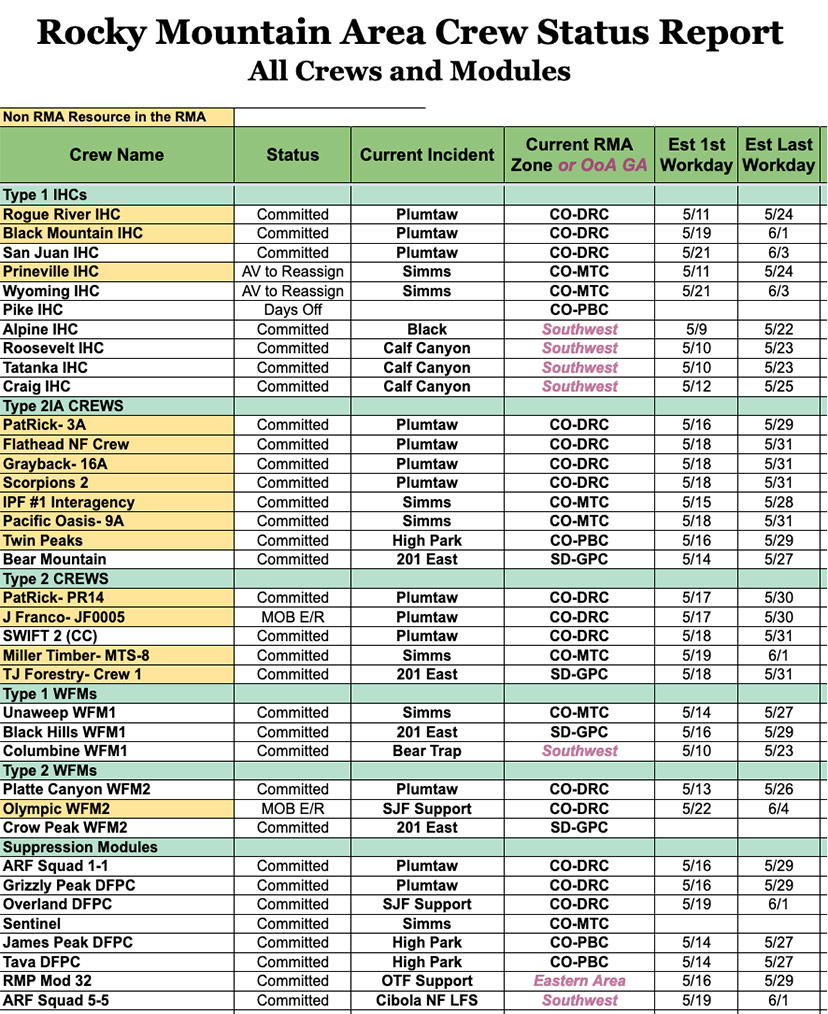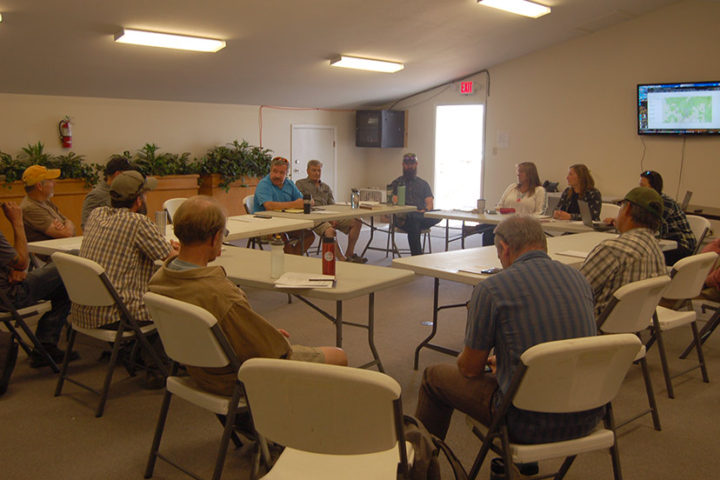Read previous Plumtaw Fire stories, beginning on May 18, here.
The view of Fourmile Road from my backyard early Saturday morning, (above) featured overcast skies and low fog (perhaps mixed with smoke?) obscuring the northern San Juan Mountains, which revealed themselves later in the day with a light dusting of fresh snow.
I didn’t smell smoke… but maybe I’ve simply grown accustomed to the fragrance, and have stopped noticing it?
As noted yesterday in the May 20 update, fresh information about the Plumtaw Fire has become somewhat harder to find, ever since the local Type 3 incident team was replaced on May 19 by the incoming Type 2 team, the Rocky Mountain Complex Incident Management Team 2.
As of May 20, a multi-mission aircraft flight had provided better mapping of the fire’s size, which was then at 727 acres. Apparently, the fire’s foot print did not grow between May 19 and May 20, in spite of gusty winds on Friday.
Cloud cover diminished fire behavior and mitigated yesterday’s wind event. Different fuel types on the fire ground, including aspen stands and grassy meadows, also moderated fire activity. These fuel types do not carry fire as readily as the Ponderosa pine and Gambel oak prolific where the fire is burning. Structure groups continued to assess and prepare structures in the Lost Valley of the San Juan subdivision and provided point protection as needed.
Team 2’s plan for Saturday:
Crews are scouting locations, including roads adjacent to the subdivision, from which they could directly engage the fire, if conditions are favorable. Structure protection work will be completed. Helicopters will do bucket work as winds allow. More resources are arriving at the fire.
The Rocky Mountain Area Coordinating Center website posts information about crew assignments (and other wildfire information) and we see, below, that a fair number of crews have been assigned to the Plumtaw Fire — a total of 13 teams, of various types. The teams shown in yellow come from outside the Rocky Mountain Area.
The original chart has been modified by the Daily Post, with only selected columns displayed. As we note, the “Estimated Last Workday” for all of these teams is “6/3” or earlier, with most listed as “5/31” or earlier. I’m not sure what to make of those dates.

As mentioned in yesterday’s update, the San Juan Headwaters Forest Health Partnership — a volunteer group of forestry experts — met on Friday at the Archuleta County Fairgrounds to discuss their favorite topic: forest health.
The group’s website home page features a photo of what an ‘unhealthy forest’ might look like.

The specific topic, planned for the May 20 meeting, was going to focus on physical treatments — especially, the removal of ‘excess trees’ and how that might make a forest healthier in terms of wildfire resilience and other factors.
But, given the ongoing Plumtaw Fire, the meeting began with a round-table discussion about the mitigation projects that had already taken place, over the past 10 years, in and around the site of the Plumtaw Fire. One of the key concerns driving mitigation projects in that particular area is the fact that the Fourmile Creek is the primary source of drinking water for the Pagosa Area Water and Sanitation District (PAWSD), and a catastrophic fire in that area could pose problems for the Dutton pipeline intake, and could also generate post-wildfire erosion in the Fourmile drainage.
The group was in general agreement about three points. One, that ‘fire’ is a natural and necessary component of forest health, and is going to play a role, sooner or later, whether we like it or not. In an unhealthy forest, the role tends to be catastrophic. In a healthy forest, fires are (theoretically) less dangerous and less damaging.
That is to say, wildfire in the forest is not a ‘bad’ thing, per se.

Another point of agreement: that the Plumtaw Fire is taking place in an area where several experimental treatments have been tried, and — for the moment — it appears that the fire is not becoming catastrophic… unlike, for example, the 300,000-acre Calf Canyon Fire, currently burning out of control in New Mexico.
Possibly, the Forest Health Partnership is partially responsible for how this wildfire event will turn out in the end?
A third point of agreement: that we shouldn’t make assumptions about how the Plumtaw Fire is going to turn out in the end, even if things look relatively hopeful at the moment. Fire behavior is too complex an issue for us to make assumptions.
Following the discussion about Plumtaw, the group heard from three companies involved in the area’s timber industry: Stateline Firewood & Logging from Durango, Forest Health Timber Products here in Pagosa Springs, and Studs Lumber Company also based in Durango.
All three of these companies are involved in the difficult business of converting unwanted trees into profitable and useful products.
Although Pagosa Springs now sees itself as a tourist destination, the town owes its existence to the timber industry, dating back to about 1895. In those days, the industry had access to huge, old-growth pine and fir trees, and did its best to harvest them as profitably is possible.
As the attitudes in the U.S. changed during the 1960s and 1970s, away from resource plundering and towards ecological sustainability, contracts to harvest from the San Juan National Forest became harder to obtain, and the timber industry in Pagosa Springs slowly dwindled away. At the same time, and as a result, the character of forest began to change… as did the character of the Pagosa Springs community.
Towards the end of the 20th century, forestry experts began to argue that 100 years of intentional and aggressive fire suppression had created unnaturally flammable forest landscapes, and that serious changes to government policy were needed if we didn’t want our carefully protected forests to simply go up in flames.
Problem is, we don’t know exactly what kind of policies are needed to fix the situation….
Or what kind of policies the taxpayers will tolerate.

